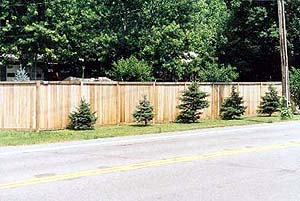RENEGADE GARDENER™
The lone voice of horticultural reason
Don’t plant evergreen trees without regard to mature size.

White Pine, doomed in 2004.
This is a very common blunder I see in every part of the country while out on my travels. Evergreen trees, among the most expensive plants you can purchase, are commonly planted too close to driveways, streets, houses, and fences.
It’s so easy to plant them correctly; just look up (or ask) what is the mature width of the tree. Most of the ill-placed trees I see are only off by four to six feet, although on occasion I’ll see a spruce planted a good ten feet too close to something that’s never going away.

Spruce, doomed in 2010.
The problem is that a tree planted thus is doomed. It’s only a matter of time before the width of the tree results in the homeowner having to hack off the branches. Not only does cutting branches make the tree look less than attractive, it takes away the tree’s vigor, and opens the plant up to disease infestation from fungi and insects.

Spruce, doomed, all five of ’em, any minute now.
Austrian Pine lend great texture and presence to the landscape, but you need remember that in the right conditions an Austrian will eventually grow 35′ wide at the base. Perhaps not the right tree to plant off the corner of the garage. The common white pine? Those babies are going to get 30′ to 40′ wide, meaning you need to plant a white 15′ to 20′ from a house, street or driveway. Spruce? The popular Black Hills variety gets 20′ wide fairly quickly, and can approach 30′ wide at full maturity.

Properly spaced planting of Black Hills Spruce.
So it pays to do your homework, to learn about evergreens, to add to your gardening knowledge. Most of the time, an evergreen shrub or shrubs is what you really want out towards the front of the yard, let’s say in a corner area created by the intersection of driveway and street. Varieties of arborvitae, hemlock, juniper, and dwarf pine and spruce might be more in line with the needs of your landscape. Large evergreen trees look a little better behind a house, off to the sides, or in the front, but only when the front yard is big enough to lend proper scale.
If good height is what you’re after but space is a little tight, get to know some of the taller evergreen trees that don’t broaden so drastically. A Blue Spire spruce is a relative of the Black Hills strain that stays more columnar, while still hitting 30′ in height. A Swiss Stone pine is going to grow upwards to 40′ tall, but only expands 15′ to 20′ wide while doing so. Balsam fir will give you all the height you need, 50′ or so, but rarely exceed 20′ in width, meaning you can plant one only 10′ from a perimeter fence.
Don Engebretson
The Renegade Gardener